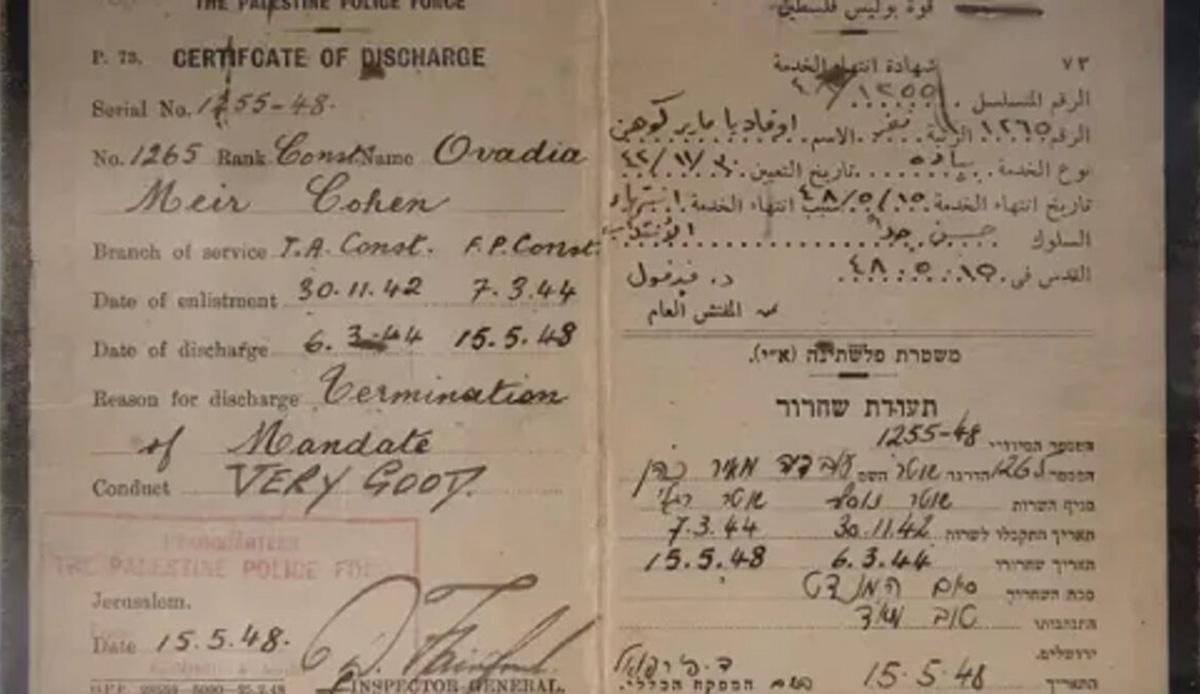OpEd - Memo to Macron: Why Don't You Learn the Facts?

MidEst Specialist Retired Lawyer Leonard Grunstein - 'The UN did not 'create' Israel. The law, historical facts and presence of the Jewish people in Israel are indisputable. Get an education.'
Memo to President Macron: the UN did not create Israel. In point of fact, United Nations General Assembly (UNGA) Resolution 181, generally known as the Partition Plan, was never implemented. By its express terms, it was merely a recommendation. While it requested that the UN Security Council take measures to implement it, this never occurred.
The Partition Plan was unequivocally rejected by the Arab world, which sought by force of arms to eliminate any possibility of a Jewish state in any part of Israel (then referred to as the Mandate of Palestine). There was no real appetite by the permanent members of the Security Council to intervene militarily to effectuate the recommended Partition Plan in the face of Arab militant intransigence or to prevent the existing Arab nations from invading and overrunning the country.
The Jews in Israel were left on their own to deal with the onslaught and invasion.
It is important to note that there is no reference in Resolution 181 to a so-called "Palestinian people". The label was invented more than a decade and a half later. There was also no reference to a so-called "West Bank". This was also an artificial construct by Jordan, which illegally annexed it, to distinguish it from Jordan proper on the eastern side of the Jordan River.
Resolution 181 just referred to the area as the hill country of Samaria and Judea. The name given to the proposed partitioned area intended to house Arab residents of Israel was the “Arab State”, not the Palestinian State.
At the time and historically, Arab residents in Israel were viewed and, indeed, viewed themselves as a part of the Arab people. As Anwar Nusseibeh explained, Arabs, who happened to reside in the area assigned to the reestablished Jewish State of Israel, saw themselves as a part of the Arab nation, generally, and specifically as a part of Syria. There was no concept of a separate so-called "Palestinian people", nor was there any distinct identity beyond being a part of pan-Arabism.
It is critical to appreciate that the UN Charter explicitly provides, in Article 80, as follows:
“… nothing in this Chapter shall be construed in or of itself to alter in any manner the rights whatsoever of any states or any peoples or the terms of existing international instruments to which Members of the United Nations may respectively be parties.”
Thus, the rights of the Jewish people to Israel under the San Remo Resolution discussed below take precedence over any UN resolution, including Resolution 181.
The propaganda effort to disassociate Jews from Israel is absurd.
International law, the French Court of Appeals of Versailles, in PLO et ano vs. Societe Alstom Transport SA et al (which decided against the claims asserted by Mahmoud Abbas, as representative of the PLO, relating to Jerusalem), the Bible and Qur’an (5:21 and 17:104) recognize the rights of Israel. The Waqf’s own Guide to Temple Mount confirms its identity with the site of Solomon’s Temple is beyond dispute and that, in the year 637 CE, Omar occupied Jerusalem. Consider too, for example, the Mount of Olives Jewish Cemetery is more than 3,000 years old. There’s no comparable Arab cemetery in Israel; the oldest dates back only to the 11th century.
It should be no surprise that Supreme Council of Allied Powers, meeting at San Remo in 1920, recognized and resolved that the Land of Israel belonged to the Jewish people, as summarized below. The 1920 San Remo Resolution was unanimously confirmed in 1922 by the League of Nations. It was also reconfirmed in the 1924 Anglo-American Convention. The law and history are a striking rebuttal to the false narrative of the Palestinian Authority (PA) and Hamas.
The Supreme Council Minutes record the discussions at San Remo regarding the area denominated as Palestine and it being a national home for the Jews. In this regard, it is important to appreciate that presentations were made by Jewish, as well as Arab delegations, asserting claims as to Palestine. Members of the Syrian Delegation met with the Supreme Council on February 13, 1919. They argued that Palestine should be a part of Syria. On February 6, 1919, Emir Feisal, as head of the Hedjaz Delegation, is reported to have said Palestine should be left on the side for the mutual consideration of all parties concerned.
Reference was made to the new area and borders of the new projected Jewish State. Consideration was also given to the civil and religious rights of the non-Jewish communities residing in Palestine. However, political rights were reserved only to the Jewish people.
The Supreme Council considered the claims of the various parties, deliberated, and decided title to Palestine was vested in the Jewish people.
In furtherance of the foregoing, the Supreme Council determined that Palestine would be reestablished as a national home for the Jews and a mandatory would be entrusted with implementing the foregoing under Article 22 of the Covenant of the League of Nations. The terms of the mandate were to be formulated by the Principal Allied Powers, who constituted the Supreme Council and submitted to the Council of the League of Nations for approval. This occurred, and the terms of the mandate were approved, as noted below. The effect was to confirm, as a matter of International Law, the re-establishment of Palestine as a national home for the Jewish People.
The Council of the League of Nations unanimously adopted the San Remo Resolution on Palestine.
It thereby became an international agreement, binding on all of the member countries, which, in effect, confirmed title to Palestine (Israel) in the people of Israel, under International Law. It recited that recognition had been given to “the historical connection of the Jewish people with Palestine and to the grounds for reconstituting their national home in that country”.
There are a number of very important legal concepts embodied in this provision of the Council resolution.
-It effectively confirmed the Jewish people as the recognized indigenous people of Palestine for over three thousand five hundred years and, as noted above, rejected the claims of others. This absolutely demolishes the fallacious claim that Jews are just modern-day colonialists.
-The Council resolution also did not purport to grant the Jewish people a newly minted right to Palestine; rather, it recorded that recognition had been given to the “grounds for” REconstituting their national home in that country. Thus, it was a pre-existing legal right that was recognized and acknowledged. Consistent with this principle, it called for “reconstituting” the Jewish people’s national home in their homeland of Palestine, not building a new national home there, which had no prior existence.
-The use of the term ‘country’ in the Council resolution is also cogent. It was no longer referred to as a geographical territory in the former Ottoman Empire; rather, Palestine was now referred to as a country. The sovereignty and legal title to the country of Palestine was vested in the Jewish people.
-Article 7 of the resolution expressly provided that the administration of Palestine be responsible for enacting a nationality law, which shall include provisions framed so as to facilitate the acquisition of Palestinian citizenship by Jews who take up their permanent residence in Palestine. In essence, International Law expressly provided for a law of return for Jews to their native homeland of Palestine [Israel]. No similar provision was made for anyone else.
As Eugene Rostow makes clear: By protecting Arab civil and religious rights,
“the mandate implicitly denies Arab claims to national political rights in the area in favor of the Jews; the mandated territory was, in effect, reserved to the Jewish people for their self-determination and political development, in acknowledgment of the historic connection of the Jewish people to the land.”
Lord Curzon, who was then the British Foreign Minister, made this reading of the mandate explicit. Lest there be any doubt, Article 5 of the Council’s resolution provided that:
“no Palestine territory shall be ceded or leased to or in any way placed under the control of the Government of any foreign Power”.
In essence, the title to the country of Palestine granted to the Jewish people at San Remo could not be revoked or granted to another by the Mandatory authority or the League. This legally includes the UN as the successor to the League. Palestine belonged to the Jewish people.
The San Remo Resolution was also a part of the Treaty of Sevres with the Ottoman Empire and, in effect, ratified by the Treaty of Lausanne of 1923 with Turkey. The Resolution of the Supreme Council of Allied Powers at San Remo was also endorsed in the Anglo-American Treaty on Palestine noted above. It actually incorporated the text of the resolution of the Council of the League of Nations, referred to above. It should be noted that the Anglo-American Treaty, among other things, provides as follows:
“Whereas the Principal Allied Powers have agreed, for the purpose of giving effect to the provisions of article 22 of the Covenant of the League of Nations, to entrust to a Mandatory selected by the said Powers the administration of the territory of Palestine, which formerly belonged to the Turkish Empire, within such boundaries as may be fixed by them;
-------
Whereas recognition has thereby been given to the historical connection of the Jewish people with Palestine and to the grounds for reconstituting their national home in that country;
---------
Article 5. The Mandatory shall be responsible for seeing that no Palestine territory shall be ceded or leased to, or in any way placed under the control of, the Government of any foreign Power.
Article 6. The Administration of Palestine, while ensuring that the rights and position of other sections of the population are not prejudiced, shall facilitate Jewish immigration under suitable conditions and shall encourage, in co-operation with the Jewish agency referred to in article 4, close settlement by Jews on the land, including State lands and waste lands not required for public purposes.
Article 7. The Administration of Palestine shall be responsible for enacting a nationality law. There shall be included in this law provisions framed so as to facilitate the acquisition of Palestinian citizenship by Jews who take up their permanent residence in Palestine.”
The Treaty was concluded and signed by the respective representatives of the US and UK in London on December 3, 1924.
- The US Senate ratified it, under its power to advise and consent, on February 20, 1925, and President Calvin Coolidge approved it on March 2, 1925.
- It was formally ratifiedby Great Britain on March 18, 1925.
- The respective ratifications were exchanged, and the Treaty was formally proclaimed on December 5, 1925.
The Treaty, thus, formally and legally recognized the right of the Jewish people to sovereignty over all of Palestine, between the Jordan River on the East and the Mediterranean Sea on the West, including, of course, Jerusalem.
Notwithstanding that the British Mandate over Palestine was terminated, nevertheless, the rights granted under the Treaty to the Jewish people survive, as confirmed by the Vienna Convention on the Law of Treaties. Therefore, it is respectfully submitted, it was and still is US Law that Jews have the right to settle in Judea and Samaria, including, without limitation, Jerusalem. This right was recognized by the President and is embodied in US law. In this regard, it is also submitted that the US may not promote a so-called Palestinian state that prohibits Jewish settlement in any part of the area of the original Mandate, including Judea and Samaria, which perforce includes Jerusalem.
The United States Constitution provides that the President “shall have Power, by and with the Advice and Consent of the Senate, to make Treaties, provided two-thirds of the Senators present concur.” Treaties are binding agreements between nations and become part of international law. Treaties to which the United States is a party that are approved by the Senate also become the ‘supreme Law of the Land’ under the Constitution, and those that are self-executing automatically have the force of federal legislation.
In ratifying the Treaty, the US legally recognized the terms of the Palestine Mandate, pursuant to the San Remo Resolution, and the historical connection of the Jewish people with Palestine, as well as the reconstitution of their national home there. In this sense, this was the first US law that recognized the Jewish people’s right to Jerusalem.
Interestingly, when the British illegally adopted the White Paper in 1939, restricting immigration by Jews to then Mandatory Palestine, a bipartisan group of fifteen (out of the twenty-five) members of the House Foreign Affairs Committee urged the State Department to protest the British White Paper and advise the British Government that it would be regarded as a violation of the 1924 Anglo-American Treaty.
The group declared that the British plan to limit Jewish immigration to the Holy Land and attempt to fix the Jews as a permanent minority was a clear repudiation of the Treaty. They also said it was the duty of the American Government to see to it that the treaty was carried out in good faith.
Yet, despite having title to and sovereignty over all of Israel, it is not the Jewish people seeking to disposes the invading Arabs, who in 1964 suddenly self-identified as "Palestinians", a label contrived as part of an illegal effort to steal the Land of Israel, it’s the so-called Palestinian Arabs who are seeking to eliminate the Jews.
And documentary sources confirming Jewish presence in Israel include:
1. 9th-century BCE Tel Dan Inscription, which references the House of David.
2. 9th-century Mesha Stele, which references the House of David.
3. 4th century BCE, Menander, a Greek historian.
4. 4th century, Hecataeus of Abdera, a Greek historian.
5. 3rd century BCE, Berossus, of Babylon.
6. 3rd–2nd century BCE, Aristeas, a Greek official in the court of Ptolemy II, in Egypt.
7. 1st century BCE, Cicero, a Roman statesman.
8. 1st century BCE, Edict of Augustus.
9. 1st century, Strabo, a Greek geographer.
10. 1st century, Tacitus, a Roman historian.
11. 1st century, Arch of Titus.
12. 1st century, Plutarch, a Greek Historian.
13. 2nd century, Cassius Dio, a Roman Historian.
14. 3rd century, Eusebius, a Greek Christian Historian and Bishop of Caesarea.
15. More than a dozen Islamic Hadiths.
16. 9th-century Muhammad ibn Jair Al-Tabari.
17. The 9th- or 10th-century Nuba inscription.
18. 10th-century geographer and Jerusalem resident, Muhammad ibn Ahmad Shams al-Din al-Muqaddasi.
19. 11th-century Abu Bakr Muhammad Ahmad al-Wasiti.
20. 12th-century geographer Muhamad al-Idrisi.
21. 12th-century geographer Yaqut al Hamawi.
22. 13th-century theologian, Ahmad ibn Taymiyyah.
23. 14th-century historian, Abd al Rahman ibn Khaldun.
24. 15th-century historian Mujir al-Din.
25. 15th-century Jalal al-Din al-Suyuti.
There is also a substantial and growing body of compelling archeological evidence of the Jewish presence in Israel that is undeniable, including the following:
2. 8th century BCE, Isaiah Seal.
3. 8th century BCE, King Hezekiah Seal.
4. Temple Warning Inscriptions (one of the two found) discovered by French archeologist, Charles Simon Clermont-Ganneau, in 1871; it warns gentiles not to enter further into the Temple compound. Josephus reports that slabs were found at regular intervals along the balustrade, in Greek and Latin, warning of the law of purification and that no foreigner was permitted to enter the holy place.
5. Beit HaTekia Inscription found by archeologist Prof. Dr. Benjamin Mazar, in 1972, which, in Hebrew, said, “lebeit hatekia lehachriz”, which means, to the house of blowing (of the trumpets) to announce. The Mishna and Talmud record the custom of sounding trumpet blasts from the Temple Mount to announce, among other things, the Sabbath (to alert people to stop work), Holidays and certain sacrificial and other rituals.
6. The lower course of the Eastern Wall of the Temple Mount, north and south of the Golden Gates, which are from the First Temple period (i.e., Solomon’s Temple).
7. High Priest’s (Kohen Gadol’s) golden bell, found by Archeologist Eli Shukron, in 2011. It is dated from the Second Temple period and is believed to be one of the bells described in the Bible, which were sewn into the bottom hem of the High Priest’s robe (Me’il).
8. The Herodian Stones, comprising the retaining wall of the Temple Mount, including the extensive portions below the present grade level, which can be seen in the Museum of the Western Wall, adjacent to the Western Wall.
9. The Herodian architecture and art, including in the entry halls of the Double Gate, under the Al-Aqsa Mosque structure, which was a part of the two sets of southern gates, known as the Hulda Gates and referenced in the Mishna.
10. A water cistern at the southeast corner of the Temple Mount platform, near Robinson’s Arch, dated back to the First Temple Period.
11. Seals and pottery shards, dating back to the time of King Solomon (10th to 9th centuries BCE), as well as, those from the First Temple period generally, including seals inscribed as belonging to the Immer family, a well-known priestly family from the First and beginning of the Second Temple period, found by the Temple Mount Sifting Project.
12. Also found by the Temple Mount Sifting Project are silver half shekel coins from the Second Temple period, many of which seem to be burnt, presumably, from the fire that led to the destruction of the Second Temple.
13. Stone tiles, dated to the late Second Temple period, based on parallels to Herodian palaces of the period, found by the Temple Mount Sifting Project.
14. Wooden beams dating back to the First and Second Temple periods were found repurposed as beams and as bond timbers in the Al-Aqsa Mosque, when it was seriously damaged in earthquakes and rebuilt.
15. A Second Temple era Mikvah (Ritual Bath) was found under the Al-Aqsa Mosque, when it was being rebuilt after the earthquake that seriously damaged it in 1927. This is in addition to the two others previously identified on the Temple Mount.
16. Remains of a defensive wall, dating back approximately 3,000 years ago, to King Solomon’s reign, situated on the edge of Jerusalem, between the Temple Mount and the City of David.
17. Pilgrimage Road, built by King Herod to ascend from the Pool of Siloam, where would ritually purify themselves on route, to the Second Temple on the Temple Mount.
The law, historical facts and presence of the Jewish people in Israel are indisputable.
Being ignorant dupes, especially arrogant ones, is not a good way to be. It is time to eschew the Hamas amen chorus. Educate yourself. (My book is a good introduction and it’s now available as an audiobook too for your listening pleasure. )
May Israel triumph over the terrorist Iranian regime and its proxies, including Hamas and Hezbollah, and bring genuine and lasting peace to the world. As Psalms 122:6 declares: Pray for the well-being of Jerusalem; may those who love you be at peace.
***
Sources: Media - NewsRael - Officials
Image - Certificate from British Mandatory Palestine/Hadash Parush

- Art
- Causes
- Analysis
- Cloak & Dagger
- Economy - Finance
- Health
- Literature
- Music
- Altre informazioni
- News & Politics
- Real Time Facts
- Sports



